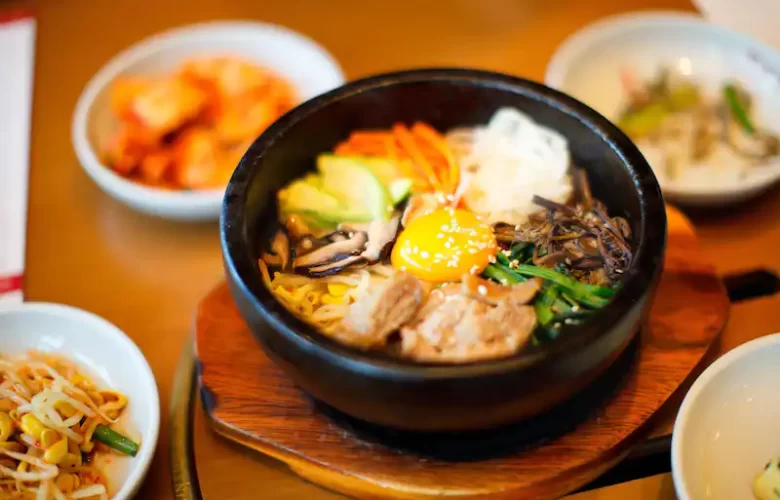Korean cuisine is characterized by a variety of dishes made with ingredients such as kimchi, rice, and meat. Korean food is discussed in this article in terms of its history, popular dishes, and cultural significance.
Introduction
The popularity of Korean food has increased throughout the world in recent years. People are falling in love with Korean food because of its bold flavors, variety of dishes, and cultural significance.
How would you describe Korean food? What is the origin of this product?
This article explores the history of Korean food, its popular dishes, and its cultural significance.
Moreover, we will provide some suggestions on what kinds of dishes to try and what ingredients to look for if you are trying Korean food for the first time.
A Brief History of Korean Food:
There are thousands of years of history associated with Korean food. A Korean cookbook dating back to the 14th century, “Siri jeonseo,” contains recipes for dishes prepared with rice, beans, and vegetables.
There are several factors that have influenced Korean food over the centuries, including geography, climate, and cultural exchange.
Since Korea is a mountainous country, rice and noodles are popular dishes, whereas the abundance of seafood along the coast has resulted in a variety of fish-based dishes.
Korean cuisine has also been influenced by cultural exchange with neighboring countries, such as China and Japan, in addition to these natural influences.
While incorporating the techniques and ingredients of these countries, Korean cuisine has also developed its unique flavors and dishes.
Popular Korean Dishes:
There is no denying that Korean cuisine is known for its bold and flavorful dishes, many of which are based on a few key ingredients. The following are some popular Korean dishes to try:
1. Kimchi:
Kimchi is a fermented dish made of vegetables. Napa cabbage is typically used as the main ingredient. A spicy, tangy side dish, it is commonly served with every meal.
2. Bulgogi:
Bulgogi is a spicy Korean dish that consists of thin slices of marinated beef that are grilled or stir-fried. Rice and vegetables are often served with it.
3. Bibimbap:
An egg, vegetables, meat, and vegetables are included in the Bibimbap dish, which is a popular rice dish in Korea. The dish is often served in a hot stone bowl, which helps to cook the egg and give it a crispy, caramelized appearance.
4. Korean BBQ:
Korean BBQ is a method of dining in which diners grill their meat at the table, typically beef, pork, or chicken. Served with kimchi, pickled vegetables, and dipping sauces, it is commonly accompanied by a variety of side dishes.
5. Japchae:
Korean cuisine consists of sweet potato noodles, vegetables, and meat. A celebration or special occasion is often the occasion for serving this dish.
6. Tteokbokki:
Served with red pepper sauce and soft rice cakes, tteokbokki is a spicy dish. Korea is known for its street food.
Ingredients to Look Out For:
There are a few key ingredients that contribute to the bold flavors that are common to Korean cuisine. When trying Korean food, it is important to look out for the following ingredients:
- Gochujang: The red pepper paste gochujang is a common ingredient in Korean cooking. The flavor imparts to dishes is spicy and savory.
- Kimchi: Kimchi is a fermented dish made of vegetables. Napa cabbage is typically used as the main ingredient. A spicy, tangy side dish, it is commonly served with every meal.
- Gochugaru: Red pepper flakes called gochugaru are commonly used in Korean cuisine. A spicy kick is added to dishes by using this spice.
- Soy sauce: Korean dishes are commonly flavored with soy sauce, which adds a savory, salty taste.
- Sesame oil: There is a fragrant oil called sesame oil that is frequently used in Korean cooking to enhance the flavors of the dishes.
- Garlic: A common Korean cooking ingredient is garlic, which adds flavor to a variety of dishes.
- Ginger: In Korean cuisine, ginger is used to enhance dishes with a spicy, slightly sweet flavor.
- Green onions: Korean cuisine often uses green onions as garnishes or as flavorings.
Tips for Trying Korean Food for the First Time:
Getting started with Korean food is easy if you follow these tips:
- Start with milder dishes: Try milder dishes first, such as bibimbap or japchae, if you are unfamiliar with spicy foods. To add a little spice, you can add some gochujang or gochugaru.
- Try a Korean BBQ: You can try a variety of Korean dishes at a Korean BBQ, which is a fun and interactive experience. Don’t be surprised if your hands get dirty!
- Don’t be afraid to ask questions: Please do not hesitate to ask your server or the chef if you are unsure what a dish is or how it is prepared. If you need assistance understanding the menu or would like recommendations, they will be glad to assist you. (lexingtonservices.com)
- Try new things: There are many different types of Korean food, so do not be afraid to experiment. You may discover a new favorite dish! You may discover a new favorite dish!
Conclusion
Korean food is a delicious and diverse cuisine that’s full of bold flavors and cultural significance. With its rich history and variety of dishes, there’s something for everyone to enjoy.
So why not give Korean food a try and see what all the fuss is about? Whether you’re a fan of spicy flavors or mild dishes, there’s a Korean dish out there for you.

